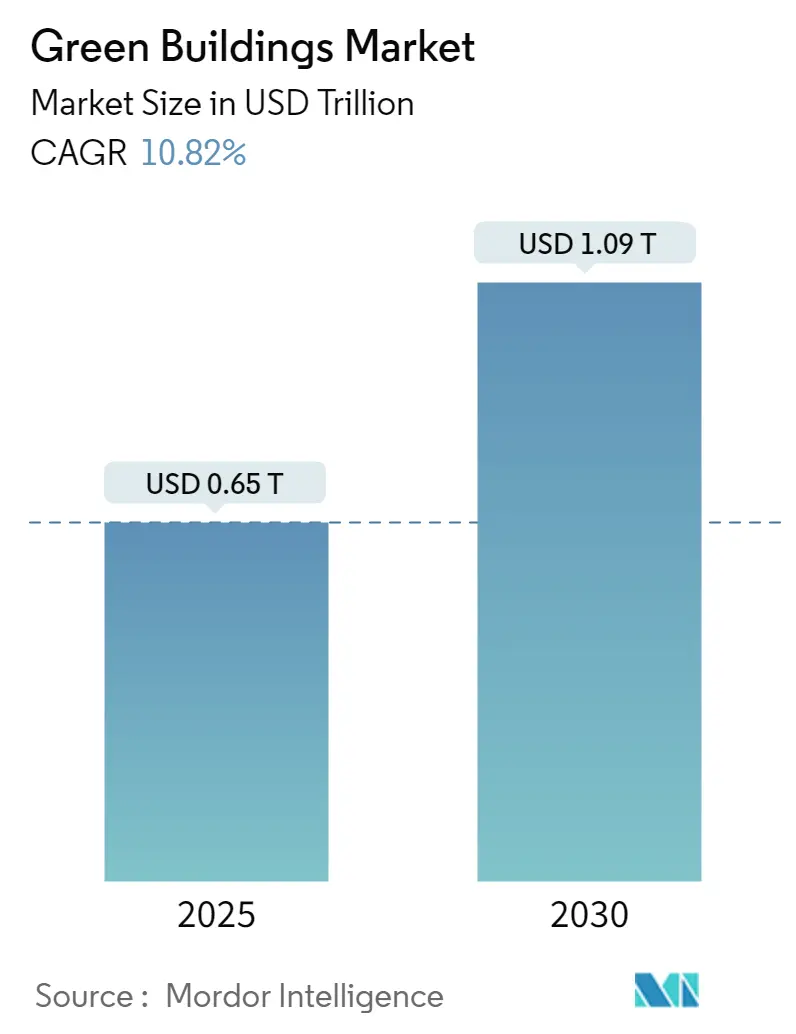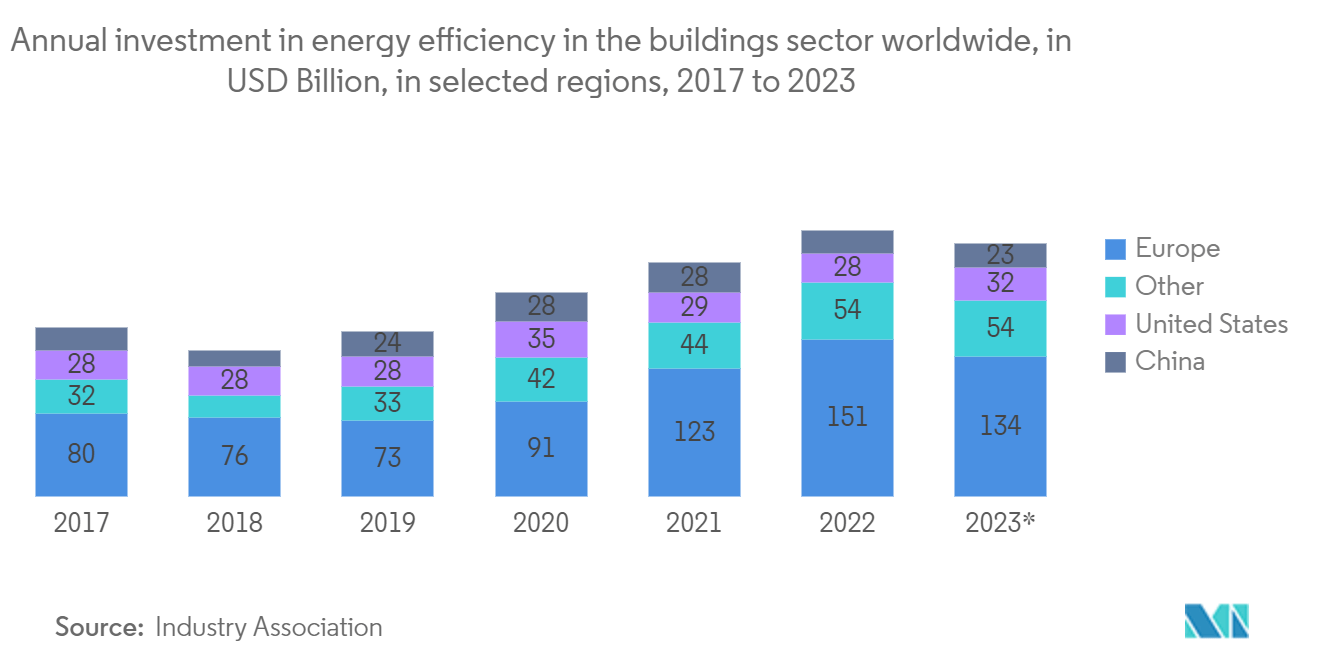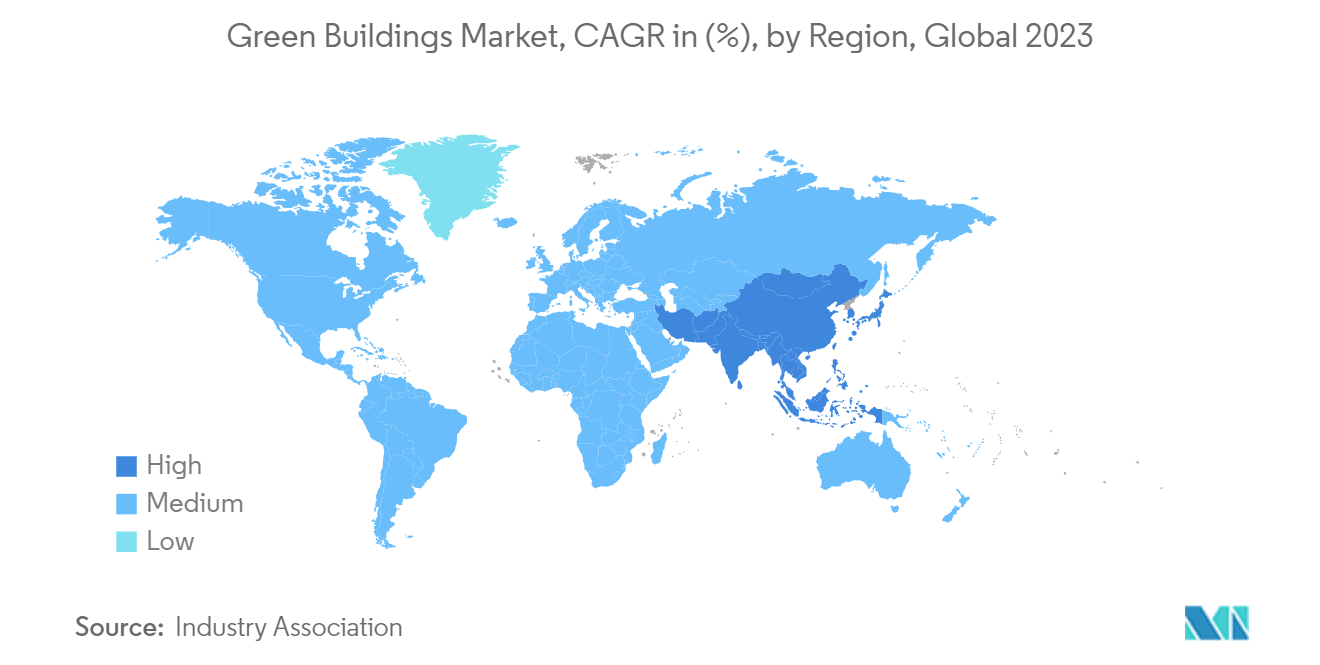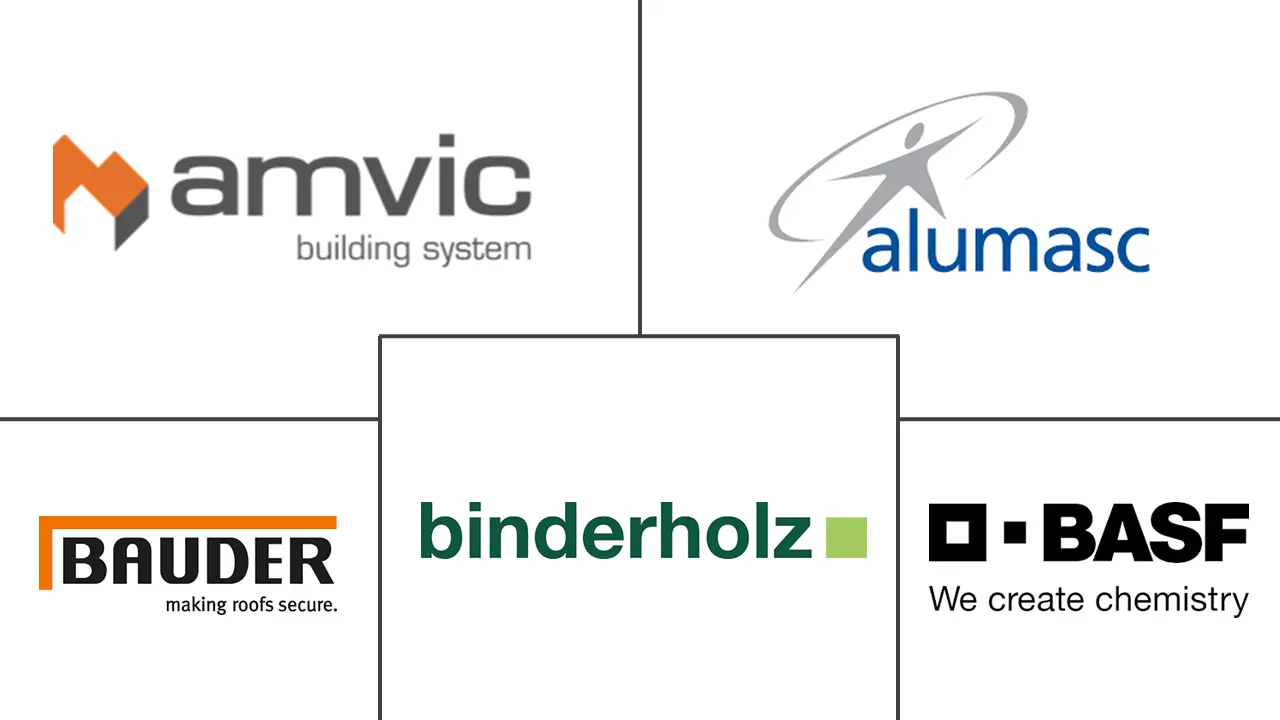Green Buildings Market Size and Share

Green Buildings Market Analysis by Mordor Intelligence
The Green Buildings Market size is estimated at USD 0.65 trillion in 2025, and is expected to reach USD 1.09 trillion by 2030, at a CAGR of 10.82% during the forecast period (2025-2030).
- The green buildings market refers to constructing and operating environmentally friendly and sustainable buildings. These buildings are designed to minimize their environmental impact, promote the health and well-being of occupants, and conserve resources.
- Green buildings incorporate various features and technologies such as energy-efficient lighting and HVAC systems, renewable energy sources like solar panels, efficient water management systems, recycled and sustainable materials, and improved indoor air quality.
- The market for green buildings has been growing rapidly in recent years due to increased awareness of environmental issues and the desire to reduce carbon emissions. Many countries have introduced policies and regulations to encourage the construction of green buildings, offering incentives and certifications such as LEED (Leadership in Energy and Environmental Design) or BREEAM (Building Research Establishment Environmental Assessment Method).
- The benefits of green buildings are numerous. They help reduce energy consumption, lower operating costs, decrease water usage, improve occupant comfort and productivity, and contribute to a healthier and more sustainable future.
- The green buildings market is not limited to commercial buildings but includes residential, educational, healthcare, and government buildings. It has become a global movement, with companies, organizations, and individuals actively adopting green building practices.
Global Green Buildings Market Trends and Insights
Increasing investment and rise in demand for sustainable buildings in the commercial segment
Corporate demand for sustainable buildings is expected to drive office market dynamics in many global markets. Across 20 of the world’s largest office markets (New York, Paris, Singapore, etc.) in the next few years, only 34% of low-carbon demand is expected to be met, one square meter for every three square meters currently in demand.
Sustainable buildings are also changing the way occupiers view them. Green certifications have traditionally been the hallmark of sustainable buildings, and tenants are willing to pay for them. JLL’s 2023 transaction evidence shows that certified buildings are still achieving healthy rental premiums across various global office market segments, but the landscape is changing.
Tenants increasingly look for environmental performance indicators (e.g., energy intensity, electrification, etc.) in addition to green credentials. For example, JLL’s 2020 transaction evidence shows that high-quality prime office spaces in London and Paris are reaching record rental heights this year, even as the sector slows down.

Asia-Pacific is growing at a steady pace
The Asia-Pacific green buildings market is expected to grow rapidly during the forecast period. This is due to various factors, such as the increasing government support for sustainable building practices, growing concerns about climate change, and increasing awareness of the benefits of green buildings.
The Asia-Pacific region has been witnessing significant growth in the green building market. The region includes China, India, Japan, Singapore, and Australia. These countries have actively promoted sustainable building practices to address environmental concerns and encourage energy efficiency.
China, one of the region's largest economies, has made substantial efforts to promote green buildings. The government has implemented policies and regulations to encourage energy-efficient construction and has set ambitious targets for green building development. In recent years, China has seen a surge in green building projects, including eco-cities and sustainable urban development initiatives.
India, another major regional player, has also made strides in the green building sector. The Indian Green Building Council (IGBC) has been instrumental in promoting green building practices and certifying sustainable projects. Many cities in India have adopted green building codes and regulations, and there is a growing demand for green buildings in both the commercial and residential sectors.
Japan has a long history of incorporating sustainable practices in its architecture and construction industry. The country has been a leader in energy-efficient technologies and has implemented strict building standards to promote sustainability. The Japanese government has introduced various incentives and certifications to encourage green building adoption.
Singapore, known for its innovative urban planning, has been at the forefront of green building initiatives in the Asia-Pacific region. The Building and Construction Authority (BCA) has set ambitious targets for energy efficiency and sustainability, and green building certifications such as the Green Mark scheme are widely recognized.
Australia, with its vast landscapes and diverse climate, has been focusing on sustainable building practices to reduce its environmental impact. The Green Building Council of Australia (GBCA) has been instrumental in promoting green building standards, and many Australian cities have adopted green building policies and regulations.
Overall, the Asia-Pacific green building market is experiencing significant growth, driven by government initiatives, increasing environmental awareness, and the desire for energy efficiency. The region is witnessing a rise in green building projects, certifications, and sustainable urban development initiatives.
The demand for green buildings in Asia-Pacific is also expected to grow due to its rapidly growing population and rising disposable income. In 2023, Asia had a population of 4.7 billion, which is expected to reach 8.8 billion people by 2050. As a result, Asia's urbanization is expected to continue during the forecast period.

Competitive Landscape
The green building market has become increasingly competitive as more countries and companies recognize the importance of sustainability and energy efficiency. Several key players have emerged in this market, each offering unique solutions and services to meet the growing demand for green buildings.
One of the major players in the market is the construction industry. Many construction companies have embraced green building practices and incorporated sustainable design principles into their projects. These companies often work closely with architects, engineers, and other professionals to ensure their buildings meet the highest sustainability standards.
Some of the major players in the market include Amvik Systems, Alumasc Group PLC, BASF SE, Binderholz Gmbh, and Bauder Limited.
Green Buildings Industry Leaders
-
Amvik Systems
-
Alumasc Group PLC
-
BASF SE
-
Binderholz Gmbh
-
Bauder Limited
- *Disclaimer: Major Players sorted in no particular order

Recent Industry Developments
- June 2023: Accenture acquired Green Domus, a leading sustainability consultancy based in Brazil, providing clients with the expertise to develop and execute a variety of sustainability initiatives with a strong focus on quantifiable decarbonization.
- March 2023: BlocPower, a green building technology startup, secured nearly USD 25 million in equity and USD 130 million in debt funding to retrofit hundreds of thousands of homes and other buildings with energy-efficient appliances.
Global Green Buildings Market Report Scope
The green building market is for buildings designed, built, and operated sustainably. This includes buildings with energy efficiency, renewable energy, water efficiency, waste reduction, and indoor environmental quality.
The green buildings market is segmented by product (exterior products, interior products, and other products ( building systems, solar systems, etc.)), by end user (residential, office, retail, institutional, and other end users), by geography (North America, Europe, Asia-pacific, Latin America, and Middle East and Africa). The report offers market size and forecasts for the green buildings market in value (USD) for all the above segments.
| Exterior Products |
| Interior products |
| Other Products (Building Systems, Solar Systems, etc.) |
| Residential |
| Office |
| Retail |
| Institutional |
| Other End Users |
| Asia-Pacific |
| North America |
| Europe |
| South America |
| Middle East and Africa |
| By Product | Exterior Products |
| Interior products | |
| Other Products (Building Systems, Solar Systems, etc.) | |
| By End User | Residential |
| Office | |
| Retail | |
| Institutional | |
| Other End Users | |
| By Geography | Asia-Pacific |
| North America | |
| Europe | |
| South America | |
| Middle East and Africa |
Key Questions Answered in the Report
How big is the Green Buildings Market?
The Green Buildings Market size is expected to reach USD 0.65 trillion in 2025 and grow at a CAGR of 10.82% to reach USD 1.09 trillion by 2030.
What is the current Green Buildings Market size?
In 2025, the Green Buildings Market size is expected to reach USD 0.65 trillion.
Who are the key players in Green Buildings Market?
Amvik Systems, Alumasc Group PLC, BASF SE, Binderholz Gmbh and Bauder Limited are the major companies operating in the Green Buildings Market.
Which is the fastest growing region in Green Buildings Market?
Asia Pacific is estimated to grow at the highest CAGR over the forecast period (2025-2030).
Which region has the biggest share in Green Buildings Market?
In 2025, the Europe accounts for the largest market share in Green Buildings Market.
What years does this Green Buildings Market cover, and what was the market size in 2024?
In 2024, the Green Buildings Market size was estimated at USD 0.58 trillion. The report covers the Green Buildings Market historical market size for years: 2020, 2021, 2022, 2023 and 2024. The report also forecasts the Green Buildings Market size for years: 2025, 2026, 2027, 2028, 2029 and 2030.
Page last updated on:
Green Buildings Market Report
Statistics for the 2025 Green Buildings market share, size and revenue growth rate, created by Mordor Intelligence™ Industry Reports. Green Buildings analysis includes a market forecast outlook for 2025 to 2030 and historical overview. Get a sample of this industry analysis as a free report PDF download.



